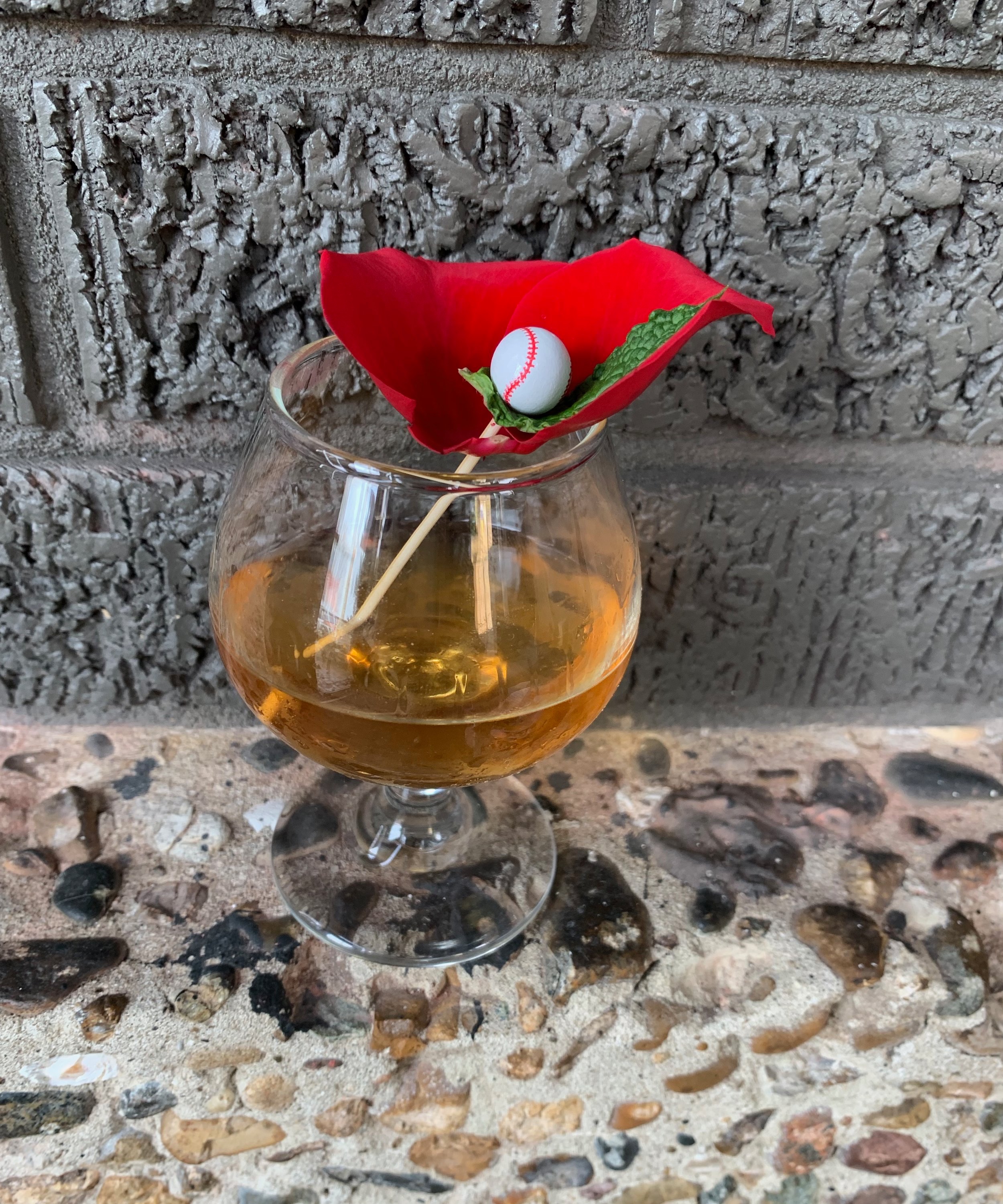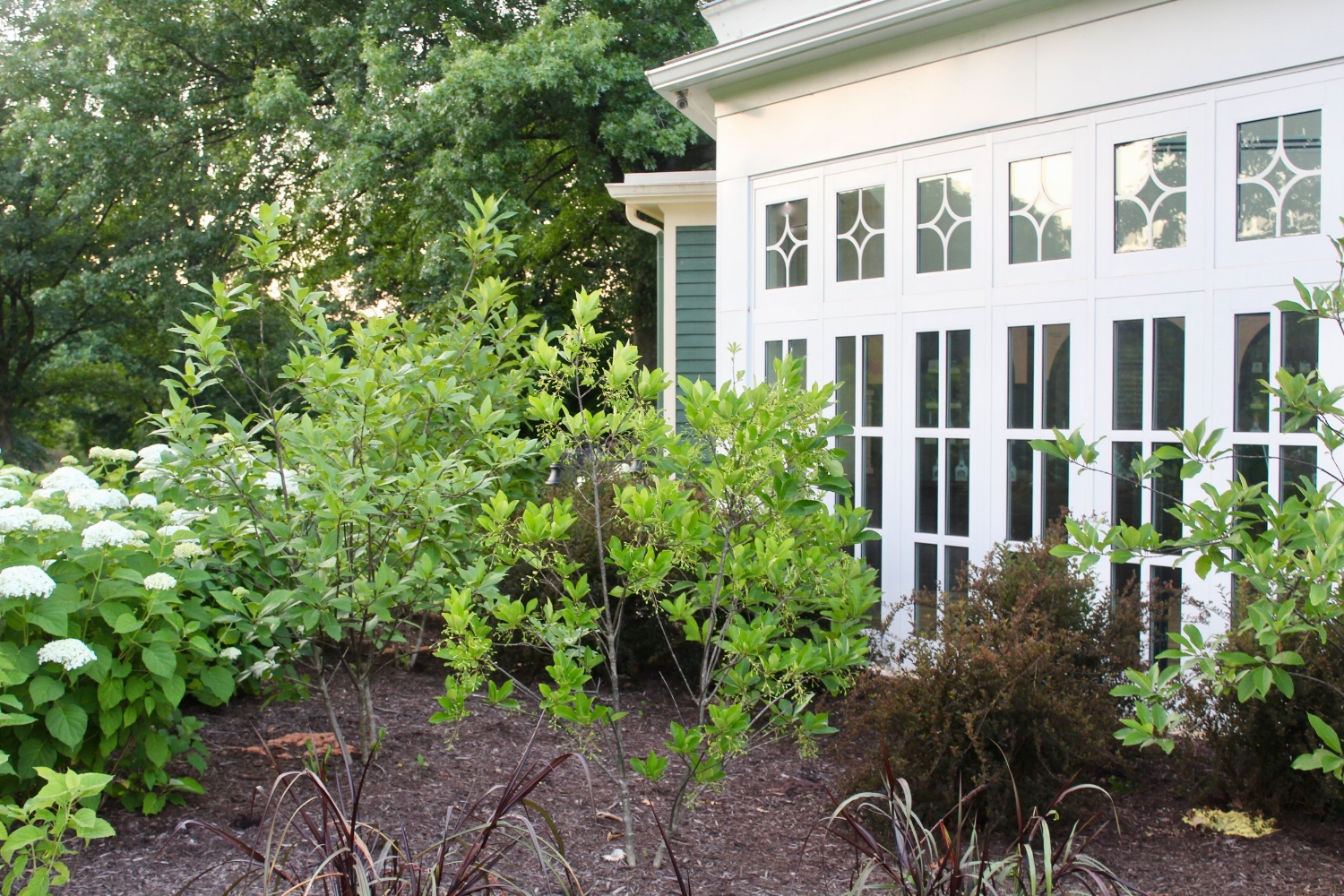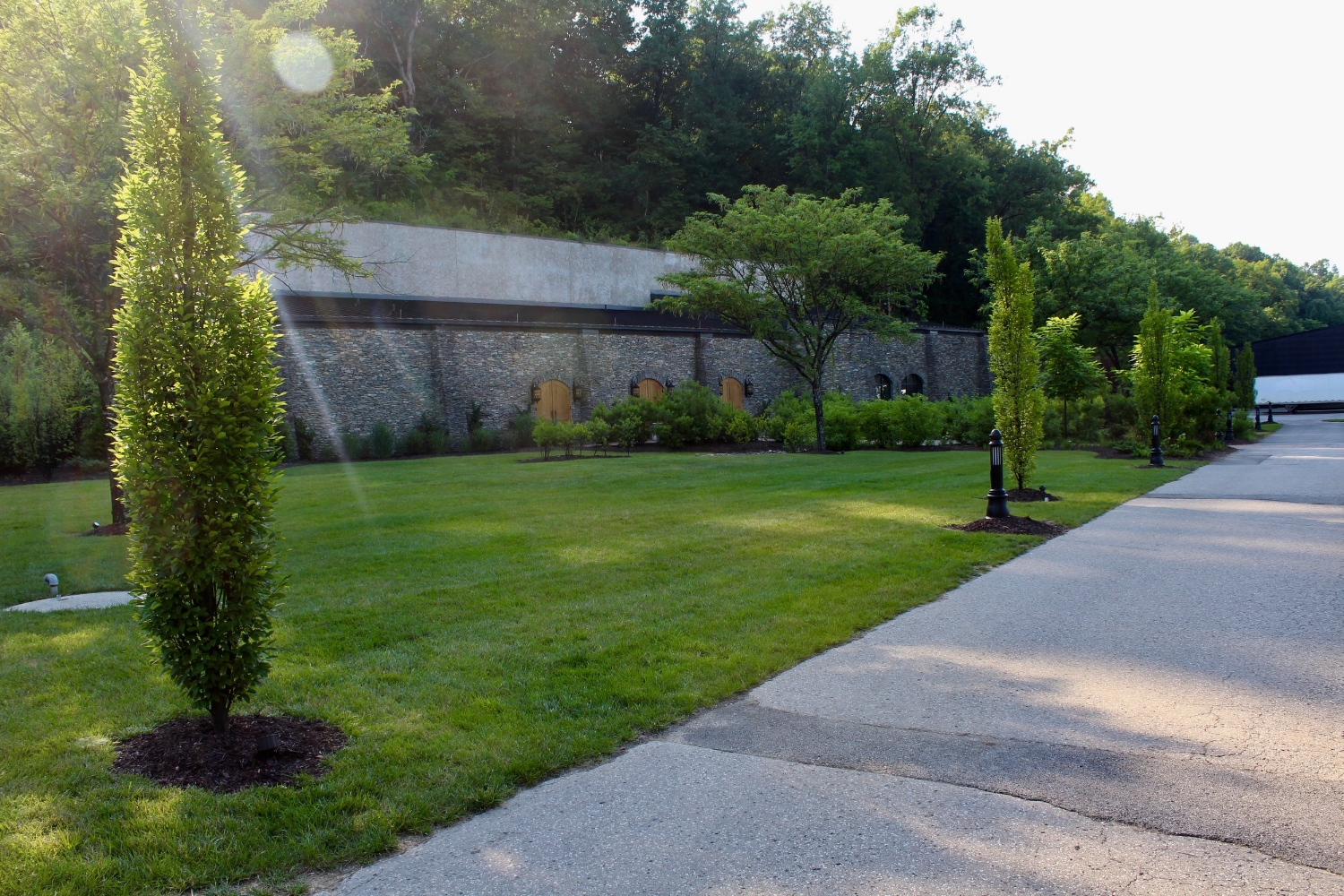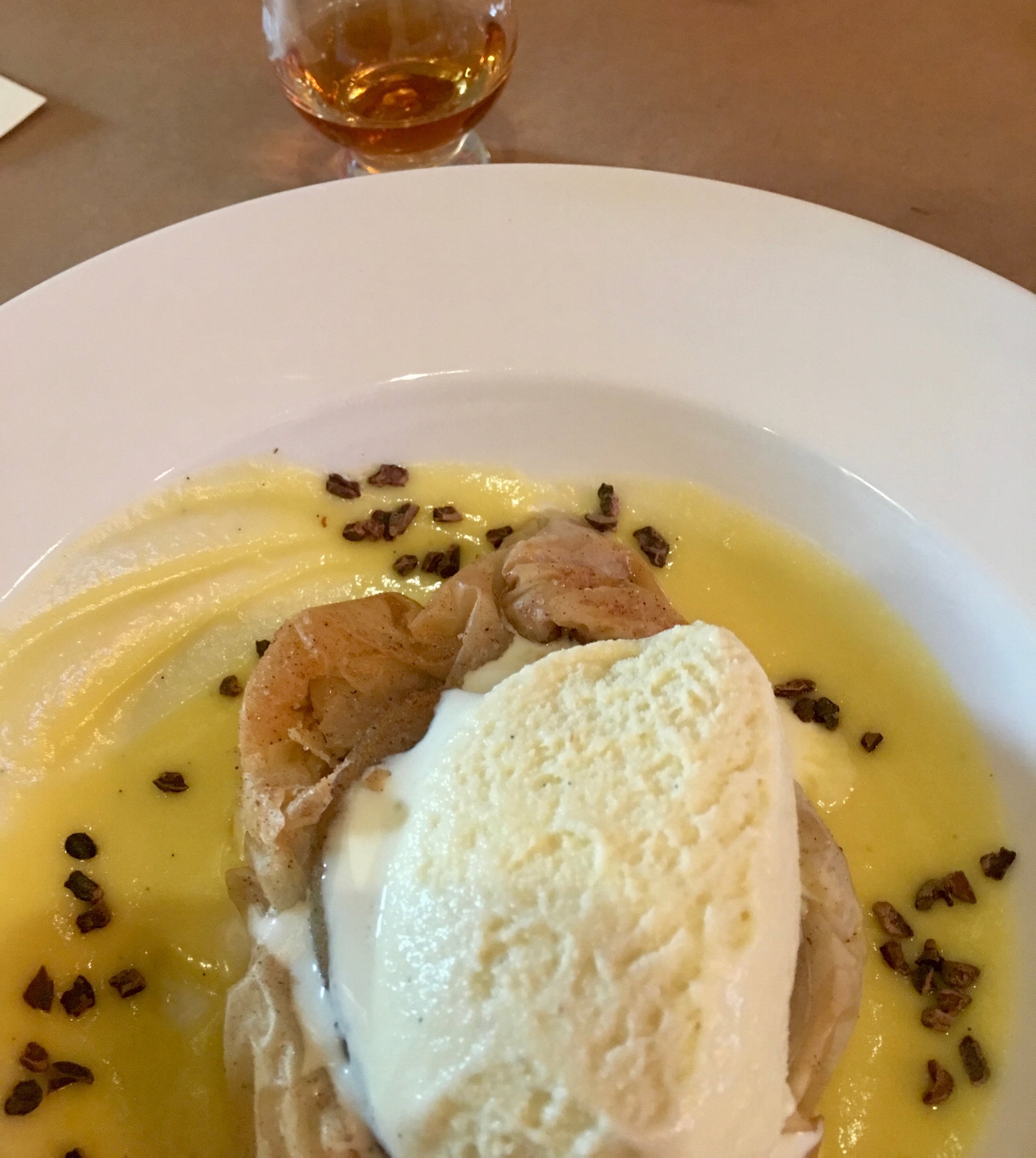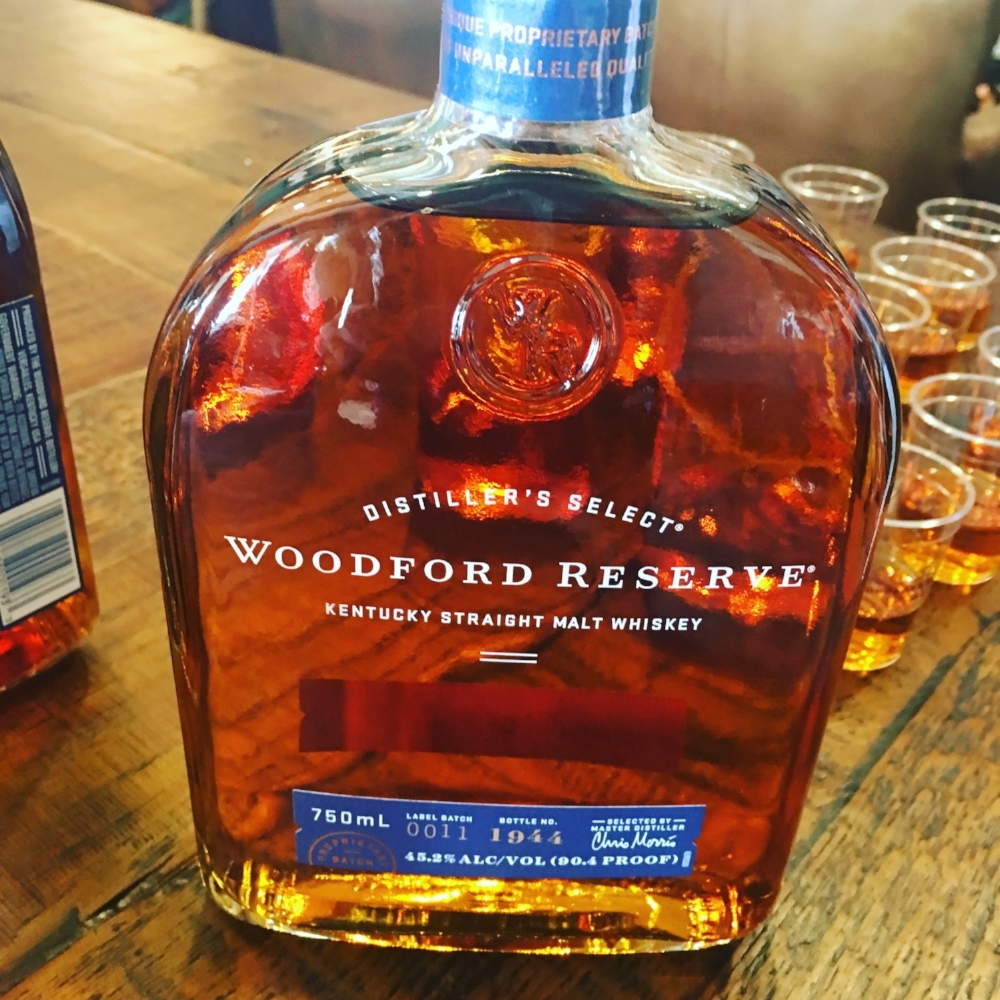BenRiach Scotch Whisky Luncheon at Ostra
Pairing Single Malt Scotch with inventive food!
The cleverly named “Peet Rose” cocktail was created by Ostra for this event.
I recently attended a lunch tasting of BenRiach Scotch Whisky at Ostra. This was an invitation I was thrilled to receive; I don’t know a ton about Scotch, and the easiest way to learn more about a spirit is to attend a tasting led by an expert. BenRiach is a 120 year-old distillery of single malt scotch; its acquisition by Louisville-Based Brown-Forman in 2016 certainly makes it more accessible to Kentucky’s whiskey lovers. Stewart Buchanan, BenRiach’s Global Brand ambassador, led us through the tasting of four BenRiach expressions, each of which was paired with a creative and delicious food course.
Stewart Buchanan, Global Brand Ambassador for BenRiach.
In walking us through the tasting, Stewart pointed out that many folks who are new to Scotch often associate the spirit with heavy notes of smoke and earth. The peat flavor is is introduced into the spirit by drying the core grain — malted barley — over peat smoke for several hours. BenRiach offers both peated and unpeated expressions, offering a lot of room for exploration of the spirit’s flavor.
Tasting notes for BenRiach Whiskys
BenRiach 10 Year:
This accompanied our starter dishes of a kale pallet, oysters, and spotted prawn ceviche. I loved the mix of a lighter whiskey with these fresh and citrusy dishes.
Proof: 86
Nose: toffee, vanilla and pear
Palate: green apple, sherry, clementine
Finish: light spice, nutmeg
Ostra’s Jay Kale salad with citrus vinaigrette and goat cheese.
BenRiach 20 year
This accompanied a main corse of Wild Boar Gemelli, truffle honey fries, and crispy brussels sprouts. Honestly, the whisky and the pasta were so amazing together that I completely overlooked my blogger duties. I loved the interplay of the gamey boar with the sweet, lightly smoky whisky. I really liked this expression a lot; the notes were more familiar for someone versed with American whiskeys.
Nose: Baked Pear
Palate: honey and red wine
Finish: lemon and barley
We finished with two peated expressions, Benriach Curiositas 10 Year and BenRiach Authenticas 25 year. These were served with two amazing desserts: the cricket flour brownies and the red velvet churros with cayenne nutella dipping sauce. While I’ve never been one for peated whiskys, this pairing really worked well to coax out the notes of the spirit. I don’t fully trust my palate enough to give tasting notes on the peated whiskys; I simply haven't worked with them enough to get a great read on what I’m tasting and smelling. The Authenticas 25 year opened up to a lovely raisin palate, which worked well to cut the indulgent chocolate notes of the dessert. (And that churro was nothing short of lfie-altering!!)
Thanks so much to Brown-Forman, BenRiach, Lemonade PR, and Ostra for the invitation. I look forward to further pursuing my nose for Scotch!
How to Taste Bourbon Like a Pro
Step-by-step guide to tasting Kentucky bourbon
Kentucky bourbon is bigger than ever. Of course, 95% of the world’s bourbon is made here in the Commonwealth, as is 100% of the bourbon that’s worth talking about. It’s an $8.6 billion dollar industry that generates over 20,000 jobs for Kentuckians. Bourbon impacts every Kentuckian. But, no matter how hot the industry is, I’ve noticed that there are plenty of Kentuckians who are still a little scared to drink bourbon. It’s a question I get fairly often from blog readers and social media followers: How do I get started with tasting bourbon?
As a bourbon writer, I’ve had the incredible opportunity to attend tastings led by some of the most interesting names in bourbon. I’ve watched the legendary Fred Noe of Jim Beam demonstrate his “Kentucky Chew” technique, participated in an intensive sensory tasting session led by Elizabeth McCall and Chris Morris of Woodford Reserve, the masters of (click here for information on how you can attend Woodford Reserve Tasting Academy, which I promise you’ll want to attend!), and been among the very first media members to sample the most recent Angel’s Envy offerings. I’ve picked up a few tasting tips along the way, and I want to share them with y’all.
Setup:
Now, it’s great if you have the opportunity to go to a tasting led by a professional. If you’re in Louisville, there are great classes at Westport Whiskey and Wine. Lexington and Louisville both have fantastic classes at Total Wine and More. And, of course, there are tasting opportunities on all of the distillery tours. But, it’s also pretty cool to setup a tasting at home, so you can learn about your own palate as well as your friends’ and family’s.
Step 1: Select your Whiskey.
If you’re going to have a whiskey tasting, you’ll want to select a whiskey. Now, many Kentucky distilleries produce a bourbon and a rye. These are both types of whiskey, and can be produced using the same equipment. Absolutely NOTHING marks you as an amateur quicker than calling a rye whiskey a “bourbon.” If you take one thing away from this blog post, please remember that. The main difference is the grain content. Bourbon whiskey must have a recipe, known as a mash bill, of 51% corn or higher, while the mash bill of rye is at least 51% rye. I find that, when selecting whiskeys to taste, it’s good to pick a theme. I often go by distiller. When sampling the new Old Forester Rye, I tried it against the Old Forester Signature Bourbon, as well as the Woodford Reserve Rye, as these were all produced under the supervision of the same Master Distiller, Chris Morris, under the two major Brown-Forman labels. Another easy starting point would be to try Maker’s Mark with Maker’s 46 or Woodford Reserve with Woodford Reserve Double Oaked. These comparisons will show you how the very same bourbon develops a different taste when finished in different barrels. You can also choose a flight consisting of one from different categories — wheated, high-rye bourbon, rye, etc. — to really see the differentiations. There is a great guide to hosting a tasting on the Kentucky Distillers Association website, and all of the major brands have really good information on their websites to help you learn about what you’ll be tasting before you buy.
Step 2: Set it up.
There really is no tasting glass like the glencairn for tasting. The tulip-shaped glass helps you experience the aroma of the bourbon as it’s supposed to be. If you don’t want to invest in tasting glasses just yet, you can use rocks glasses. Set up each tasting station in the same order, pouring about an ounce of whiskey into each glass. We’re not here to take shots or get drunk. The idea is to have enough juice in each glass to get an idea of how it tastes. Set your samples out in ascending proof order, so that a higher proof won’t overwhelm the flavors of a lower-alcohol spirit.
Step 3: Accoutrements
Turns out, you actually do need a few more things on hand for a bourbon tasting than just bourbon and glasses. Who knew, right?!?! You’ll need some good quality, flavor-neutral water. Here in Louisville, the best thing is actually our award-winning tap water, but to paraphrase Ina Garten, bottled water is fine. The water serves both as a palate cleanser and, if needed, for a drop or two to dilute the spirits. Sometimes, after the initial taste of the whiskey, it’s nice to add a little water (no more than a drop or two) to cut the proof and really dig into the flavor.
You’ll also want some crackers, bread, or popcorn to serve as a palate cleanser while tasting. And, although we’re limiting the amount of alcohol that’s being consumed in the tasting, you’ll want to have some appetizers or snacks on hand to offset the intoxicating effect. It’s also interesting to try some different food samples with your whiskey tasting to coax different flavors out of the drink. The Woodford Reserve flavor wheel tasting calls for aged parmesan, toasted hazelnut, dried cranberry, an orange slice, dark chocolate, and sorghum. I often make some substitutions when playing around with food pairings: I like Kerrygold Dubliner cheese rather than parmesan, and often use fresh or dried cherries and toasted pecans — these are just my taste preferences, and serve a similar purpose in drawing different notes out of any whiskey, not just the Woodford expressions.
Tasting
So here’s the thing. You honestly already have the only tools you need for a bourbon tasting: your own taste buds and curiosity. The most important thing here is taking the time to really be in touch with the sensory experience. Don’t let yourself fall into the trap of liking what you’ve heard is good, what “the experts” like, or what the people around you say is good. You know what you enjoy. You know if you like Brussels sprouts or red meat or chocolate cake, right? Well, bourbon is no different. Different people have different palates and enjoy different spirits. At the heart of it, that’s how the bourbon industry came to be.
Step 1: Color
The first thing you’ll notice when approaching your bourbon samples for tasting will be the color. The color actually does play a huge role in the tasting experience. The shade of amber of a particular whiskey will often be determined by its proof, age, and degree of barrel char. The above photo is a great illustration of how color predicts the character of a bourbon. Two Coopers’ Craft expressions were made from the exact same mash bill. The original Coopers’ Craft is an 82.2 proof, aged in charred barrels, while the Coopers’ Craft Barrel Reserve is 100 proof and has been aged in a specially chiseled barrel. Both of these factors impact the color of the bourbon, and give you the first clues about how it will taste. Predictably, the sample on the right, the 100 proof, has a far bigger and more complex flavor.
Step 2: Aroma
Your sense of smell has a huge impact on any food or drink that you taste. To get a full sense of a bourbon’s flavor, you should take the time to give it a good sniff before you taste it. Now, to the beginner, the first notes you’ll smell in any bourbon whiskey will probably be vanilla and caramel. These are characteristics of all bourbon whiskeys; they are the result of aging the spirit in charred oak barrels. Sometimes these notes linger beyond your first whiff, and they’re still pretty wonderful. As you smell the spirit, you’ll probably pick up on some other notes, too. These are the result of the specific yeast strains, grain varietals, barrel chars, maturation techniques, and everything else that goes into making a specific whiskey. Pay attention to what you smell. There are no wrong answers. I find that most of the Brown-Forman brands have a really strong pear note. Maker’s Mark expressions smell like creme brûlée. Explore the aroma for yourself and note how smells you enjoy play into flavors you like. If a whiskey has a strong raisin note and you hate raisins, then you’re probably not going to enjoy that spirit. Also, it’s very interesting to see how different conditions — a hot or cold day, how you’re feeling, etc. — play into the aroma you experience for a whiskey. It’s very common to smell something different in the same whiskey on a different day, even for folks who have a highly trained and developed palate.
Step 3: Taste
We’ve spent a lot of time getting to this point, haven’t we. Especially since the goal was supposed to be tasting a whiskey. Well, here we are.
Take a sip. See how it tastes on different parts of your tongue. Really think about the flavors you’re pulling out of the whiskey. Pay attention to your initial, emotional responses. Maker’s Mark always tastes like Christmas to me, both because of its elegant caramel and vanilla notes, but also because of the sensory memory of my great-aunt’s bourbon balls, which she always made with Maker’s Mark. You may sense a nutty flavor or a fruity note; subsequent sips or dilution with water will probably help you figure out what kind of nut or fruit. . If you’re tasting with other folks, you may hear them talk about notes that you absolutely do not taste; this is absolutely normal. There are usually some big notes that everyone experiences, and then other flavors that are way more about the bourbon’s impact on the individual. Some of the most experienced Master Distillers and Master Tasters and bourbon pros I’ve ever met will tell you the same thing: There is no right or wrong way to taste, and everyone picks up on a little something different. Trust your palate and your experience more than reviews, price point, or prestige. I promise this will make you a happier bourbon drinker.
Step 4: Finish
Think about the flavor the whiskey leaves in your mouth after you swallow (or spit) it. Maybe there’s a cinnamon note, or citrus fruit. It’s the final impression of the whiskey, and it often is a little more complex than the first taste.
Step 5: Record it
So, this is totally optional, but I find that the best way to develop my taste in bourbon is to keep a tasting notebook. I use this one, which is popular among the bullet journal crowd. I find that keeping my notes organized helps me to really compare flavors and experiences. I can look back on what I tasted in a specific whiskey and see if I taste the same notes again. It’s a great way to help me recall what I’ve tasted and what flavors I’ve tasted. If you’re interested in taking up bourbon tasting as a semi-serious hobby, I recommend journaling it.
Cheers, y’all! Let me know in the comments if you’ve ever done a bourbon tasting at home or at a distillery!!
Angel's Envy Oloroso Sherry Cask Finish Bourbon Review
Tasting notes on a very limited edition bourbon expression.
Last week, I attended a media preview and tasting of the latest release from Angel’s Envy: Oloroso Sherry Cask Finish Bourbon. Angel’s Envy is one of those small, family-owned whiskey labels that has a cult following — fans love the unique bourbon and rye whiskeys finished respectively in port wine or rum barrels to provide a gently altered flavor profile. The limited release Oloroso Sherry Cask Finish was a pretty big deal to bourbon geeks: it was the first new Angel’s Envy expression produced since 2013, and the first to be produced without the guidance of famed patriarch and Master Distiller Lincoln Henderson.
A mural at the entry of Angel’s Envy pays tribute to legendary distiller Lincoln Henderson
Lincoln Henderson was the Master Distiller for Brown-Forman for 40 years; he created the Woodford Reserve and Gentleman Jack expressions while at B-F. Lincoln retired in 2004, but by 2006 his son Wes persuaded him to come out of retirement work on a new, family-owned distillery project. The result was Angel’s Envy, a name paying humorous homage to the fabled “angels’ share”, the portion of the whiskey that evaporates in the warehouse each year. Mr. Henderson passed away in 2013 at the age of 75; Wes Henderson and his sons Kyle and Andrew continue to run the family business with an eye toward their patriarch’s vision.
Henderson Family Tree
Wes and Kyle Henderson sample new make.
After a quick tour of the distillery, Wes and sons Andrew and Kyle treated our media group to the first “outsiders’” taste of the new, limited edition bourbon expression, Angel’s Envy Oloroso Sherry Cask Finish.
Tasting Notes:
Proof: 100
Nose: Raisin and New Oak
Taste: Sherry, Raisin, and Hazelnut with a secondary toffee note.
Finish: Oak and Floral
This is a really unique expression. I LOVED the nose on this. It was this gorgeous raisin and oak scent that felt like a storybook holiday. The sherry definitely came through on the initial taste; we were told that Oloroso is a drier sherry, specifically chosen to keep the whiskey balanced and not overly sweet. I could see this making a really sophisticated and subtle Manhattan.
This is a very limited run of 3,600 bottles at $199 each. The whiskey will be available at the Angel’s Envy Distillery Store in downtown Louisville and distributed to a handful of Louisville area liquor stores. Public sales will begin on February 15th at 8 am; you can add your name to the VIP Access list by joining the Angel’s Envy 500 Main Club.
After the tasting and lunch, we were treated to a cocktail class with Finishing Room Bar manager Mike Bohn. Mike was so knowledgeable about the history of cocktails and the best ways to coax flavors out of the whiskey. You can sign up here for your own cocktail class.
Thanks so much to Angel’s Envy for the opportunity to sample this new expression!
Old Forester Distillery
Louisville’s must-visit distillery tour
I’m frequently asked what I recommend on a short list of Louisville tourism destinations — where to go if you only have a day or two to spend in the Derby City. I also often hear folks wondering where to start their bourbon tourism education. The Old Forester Distillery is the perfect answer to both of those questions.
Old Forester was the first bourbon whiskey to be sold exclusively in sealed bottles, and it’s the oldest bourbon on the market. It was even produced during Prohibition for medicinal use. If you want a great primer on the history of Kentucky bourbon — sales, marketing, and production — you need to visit Old Forester.
At the turn of the 20th Century, the 100 block of Louisville’s Main Street was integral to Kentucky’s bourbon industry. Over the years, production and storage facilities moved to more spacious areas, with Whiskey Row revitalization efforts only arising over the past few years. Brown-Forman built the Old Forester Distillery on the site of the brand’s original headquarters, providing both a tourism facility and a working distillery on history Whiskey Row.
In addition to giving visitors an overview of how the bourbon is made, the Old Forester tour actually gives its guests a glimpse into the cooperage process. Brown-Forman, Old Forester’s parent company, is the only distilling company that makes its own barrels. This tradition is honored at OldFo, as you can actually watch barrels being constructed and charred as part of the tour.
Don’t miss the gift shop which offers the Whiskey Row series (the 1920 blend is fantastic!) and the Distillery-Exclusive President’s Choice single barrel blend!
The Old Forester Distillery is open for tours and shopping 7 days a week at 119 West Main Street in Louisville. The $16 tour includes a tasting for guests over 21. Click here for more tour details.
Maker's Mark TasteMaker's Dinner Honoring Chef John Currence
Gourmet dinner at Maker’s Mark Distillery celebrating Mississippi-based celebrity chef John Currence.
I love this chandelier at Star Hill Provisions, the distillery restaurant at Maker's Mark
Bob and I had the opportunity to visit the Maker's Mark Distillery this weekend to attend the TasteMaker's Dinner Honoring Chef John Currence. Now, if Chef Currence sounds familiar, it may be from Season 3 of Top Chef Masters. Or from The Mississippi Delta episode of Anthony Bourdain's No Reservations. Or, you may have seen one of the many issues of Garden & Gun which sing the praises of his four restaurants in Oxford, Mississippi. Well, you get the idea. Chef Currence knows Southern Food.
Visitors Center, Maker's Mark.
Visitors Center, Maker's Mark (Can you spot the Distillery Cat??)
It was a beautiful, if warm, Southern summer night, so we took the hour-or-so "scenic route" to Loretto from Louisville. With work opportunities for the book, I've been fortunate enough to visit Loretto pretty frequently over the past couple of years, but Bob hadn't had the chance to see some of the newer additions like the Tasting Cellar and Star Hill Provisions. To me, one of the most special things about the Maker's Mark campus is the strong commitment to building new structures that fit nicely with the original Victorian architecture from the property's days as Star Hill Farm and Burks Springs Distillery. In researching my book, I've been able to speak with several folks -- including Chairman Emeritus Bill Samuels Jr -- about the strong commitment to preserving Mrs. Margie Samuels's original vision of the distillery, honoring her design choices in every new project. If you haven't been out to Maker's Mark in a few years, you're in for a real treat; all the familiar Victorian elements are there, but the campus has been upgraded in so many new and beautiful ways!
Tasting Cellar, Maker's Mark Distillery
Star Hill Provisions, Maker's Mark Distillery. I love the Kiptoo Taurus sculpture displayed to the right of the mural.
The event kicked off around 6 p.m. with hors d'oeuvres: pimiento cheese beignets (which basically combines everything I love on earth) and pickled shrimp salad gougeres. The shrimp salad, served on tiny little croissants, was amazing, and I resolved at once to replicate the recipe! This course was accompanied by a Maker's Mark-spiked University Greys' Punch. A bluegrass duo performed on the patio, but we sought refuge from the heat by ducking into the side bar at Star Hill Provisions. It was so cozy and charming!
Punch at Maker's Mark
I sadly forgot to capture a photo of the soup course, which a chilled celery veloute with crabmeat and butter-toasted bread crumb. It was a great night for a chilled soup, and I never say no to crabmeat! This course was followed by a Maker's Mark highball.
The salad course, crisp and refreshing with a peppery bite, featuring Maytag bleu cheese, roasted tomato vinaigrette, and pickled apples.
We then were served a Maker's 46 Manhattan. I love Maker's 46 for a cocktail; I think the spirit's complex flavor stands up so well when mixed.
The entree course was bourbon-braised pork belly with celery root puree and a casserole of crispy Brussels sprouts and lardons. I seriously loved that casserole, y'all. It combined the comfort of my mom's broccoli casserole with a well-made mornay sauce and charred Brussels sprouts. This is another dish I hope to recreate at home!
We finished with a bourbon and clove poached pear served in phyllo with Maker's Mark frozen custard and bitter cocoa nibs. The course was accompanied by Star Hill Provisions' Maker's Mark Private Select. The Private Select program has created so many interesting expressions of Maker's Mark. It's so interesting to try different barrels and see how different folks' tastes run.
As longtime fans of the Maker's Mark brand and the distillery campus, we took a moment to walk around after dinner to notice all the beautiful new additions to the setting -- we even caught glimpses of frolicking rabbits and a lounging distillery cat! Bob noted how very much the distillery has changed from the late 90s, when the tour was a bare-bones look at how the bourbon is crafted. It was a fun evening of food and cocktails in a perfect setting!
Thanks so much to Maker's Mark for inviting us out to experience this fun event! The next TasteMakers dinner will honor Chef Edward Lee and will be held on Saturday, July 14. You can purchase tickets here.
Woodford Reserve Kentucky Straight Malt Whiskey
A tasting event for Woodford Reserve’s latest whiskey expression.
During Derby week, I had the amazing opportunity to visit the Brown-Forman suite at Churchill Downs for a day of bourbon and horse racing. Seriously, who could turn down that combo?
The Woodford Reserve Suite at Churchill Downs. Shop the Draper James Throw here.
The tasting event was held on the Wednesday before Derby, a day which I hope never gains a nickname as "cute" as Thurby, and which still retains the charm of a locals' day at the track. As Woodford Reserve Master Distiller Chris Morris and Assistant Master Distiller Elizabeth McCall poured cups for tasting, we learned that a group of bourbon media professionals had been assembled for the first tasting of Woodford's new Kentucky Straight Malt Whiskey, a product which will be available for purchase in some markets as early as next month.
If you ever have the chance to attend a Woodford Reserve whiskey tasting, you owe it to yourself to participate. The Woodford team puts so much care into the details -- whether they're doing the signature flavor wheel food pairing exercise or a comparative whiskey tasting, as we experienced on this occasion. Mr. Morris took care to explain that all four expressions in the brand's whiskey portfolio -- Woodford Reserve Bourbon, Woodford Reserve Double Oaked, Woodford Reserve Rye, and Woodford Reserve Malt -- were comprised of the same three grains: corn, rye, and malted barley and are bottled at 90.4 proof. Of course, the percentage of grains in the individual mash bills as well as the special finishing process in the case of Double Oaked are what produce such distinct flavors in the different distillates.
We started with the original WR expression, the bourbon as a baseline spirit for tasting. We followed with my favorite expression in Woodford's portfolio, Double Oaked. The Double Oaked is traditional Woodford juice that, upon maturation has been finished in a second charred oak barrel. This produces more of the sweet caramel notes for which the brand is famous. I love this one as a sipping whiskey or as an after-dinner "dessert" drink, as it has prominent brown sugar notes; it's sweet without ever becoming cloying.
Next on the tasting menu was Woodford Reserve Rye. This one is Bob's go-to cocktail whiskey; it makes a fine Manhattan, sour, or Old-Fashioned. It's peppery and earthy, but doesn't enter into the high-rye herbaceous "bite" that so many ryes often display. We consider it the "house whiskey" of HerKentucky Headquarters; I love the idea that this rye whiskey is made from Brown-Forman's pre-Prohibition recipe.
Elizabeth McCall leads a tasting of Woodford Reserve whiskeys
Then it was time for a sip of the new malt product. This one was fascinating, y'all. It had a lot of the characteristics of traditional Woodford bourbon, but was somehow lighter. The nose was strong with notes of cherry and almond. The mouthfeel was quite different from any of the other whiskeys we tasted that day; I felt a strong evaporation on the front of my tongue, somewhere between the sweet and salty tasting zones. I think that the Straight Malt expression will make a really interesting whiskey for mixologists; it will create some unique cocktails!
Mr. Morris made the very important distinction that this whiskey is not to be considered in the class of single malt Scotch whiskeys, but rather it is an experimental expression of American whiskey. Elizabeth led us through the tasting notes, as you can see in the video below.
Elizabeth and I also had a chance to chat about some of our favorite Draper James pieces. She was featured on the brand's Love, Reese blog as part of the Real Women, Real Clothes series, and partnered with Draper James on her Derby Week looks. How perfect is that partnership? We posed for a #draperjamesgirl photo as the event wrapped up.
Draper James Girls at the track. Shop Elizabeth's dress and my dress. (My fascinator is c/o Off Broadway Shoes and my necklace is from Elva Fields.)
Thanks so much to Woodford Reserve for an amazingly relaxing and educational Derby Week event! Cheers, y'all!
10 Terms that Bourbon Beginners Need to Know
How to talk about bourbon like an insider
Bourbon is everywhere these days, y'all. In 20 years, it's gone from the drink you enjoy at Kentucky's racetracks to the quintessential American spirit. Of course, here in Kentucky, we're at the heart of the bourbon boom, which is wonderful for everything from the tourism revenue to the resultant Kentucky culinary renaissance. But, I've noticed a little secret that we don't always want to admit: Not every Kentuckian is a bourbon expert. I've decided to start a series of HerKentucky blog and social media posts to help you decode the secret language of bourbon. Today, we'll start with a little bourbon dictionary. Here's the lowdown on ten whiskey terms that will have you talking like a bourbon insider in no time!
What are you drinking: Whiskey, bourbon, or rye?
Bourbon's mash bill is 51% corn. Jeptha Creed uses an heirloom varietal, Bloody Butcher Corn.
Whiskey: Whiskey is a distilled spirit made from fermented grain mash. These grains are, most often, wheat, barley, corn, or rye. The grain recipe (mash bill) that is used to produce the whiskey is responsible for much of the beverage's taste. Whiskey types (Scotch, Irish, Bourbon, etc.) are often determined by the spirit's country of origin. An alternate spelling is "whisky"; this is the traditionally accepted spelling in Scotland and many other countries.
Bourbon Whiskey: Bourbon Whiskey is a type of whiskey made in the United States. By law, bourbon must be produced in the United States, comprised of at least 51% corn, aged in new, charred oak containers, distilled to no more than 160 proof (80% alcohol by volume), entered into the barrel for aging at no more than 125 proof (62.5% alcohol by volume), and bottled at 80 proof or above. While we all know that the best bourbon comes from Kentucky, federal law does not mandate that the spirit be produced in our Commonwealth. For an excellent history of the legislation surrounding bourbon, see Fred Minnick's Bourbon: The Rise, Fall, and Rebirth of an American Whiskey.
Rye Whiskey: American Rye Whiskey is a distillate that must include at least 51% rye in its mash bill. (Canadian rye whiskey is a different spirit.) Historically, rye whiskey was produced near Pennsylvania; Pittsburgh was historically considered the major metropolitan hub for rye. Rye wasn't a spirit considered native to Kentucky for centuries, as our climate isn't conducive to growing that grain. Many major bourbon distilleries have recently introduced rye to their whiskey offerings. Rye whiskeys are often characterized as more herbaceous and less sweet than bourbons. I recommend Manhattan cocktails made with Michter's Rye or Woodford Reserve Rye as an entry point for rye whiskey.
How is it made?
Fermentation Tank at Woodford Reserve.
Mash bill: A mash bill is the mix of grains combined to make a whiskey. The grains are cooked and fermented. Three grains are typically found in a bourbon mash bill: corn, wheat or rye, and malted barley. The individual mash bills, or recipes, determine most of a whiskey's flavor. A wheat mash bill, like that of Maker's Mark or Pappy Van Winkle, results in a sweet bourbon. A high rye formula, like that of Bulleit or Basil Hayden's, is often described as spicy.
Sour Mash: The sour mash process of whiskey-making involves using a little spent mash from the previous batch to start the fermentation of the next batch. This process controls the growth of harmful bacteria and regulates the whiskey's pH. This process is used to make almost all bourbon whiskey.
How is it Bottled?
The Bottling Line at Maker's Mark
Straight Whiskey: Take a look at your bourbon label sometime, and you'll likely see the term "Kentucky Straight Bourbon Whiskey." This means that, of course, it is produced in Kentucky (the label, by law, must contain the state of distillation) and that it adheres to the regulations for bourbon, as defined above. Straight whiskey has been aged for at least two years; if it is aged for less than 4, the age statement must, by law, be noted on the label. Straight whiskey may be created by blending bourbons that were aged in different batches and even different years to create a consistent product. No additional additives (color, flavor, clear spirits) other than water (which tempers the proof) may be added to straight whiskey.
Bottled-in-Bond: Bottled-in-Bond bourbon was made at a single distillery, by one distiller in one distillation season, aged for at least four years in a federally bonded and supervised warehouse, and bottled at 100 proof. The Bottled in Bond Act of 1897 is considered a revolution in bourbon-making, as it ensured both quality for the consumer and standardization of the federal taxes levied on the distillers. Bottled-in-Bond whiskeys are far less common than they once were; you may see this distinction on some bourbons like Old Fitzgerald and Old Bardstown.
Single Barrel: Single bourbons are, as the name suggests, a limited release in which every bottle comes from one barrel. Due to the variations and scarcity, these are often an ultra-premium expression. Blanton's is the first bourbon that was widely marketed as a single barrel.
Small Batch: Small batch bourbons are made from a highly limited number of barrels per batch. Maker's Mark and Willett are considered small-batch bourbons.
These terms should have you talking bourbon like a pro! (Or at least an experienced amateur!) Let me know in the comments if there are bourbon basics topics that you'd like to see posts about!

